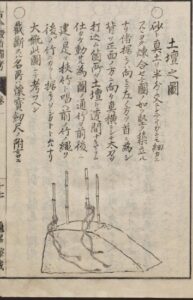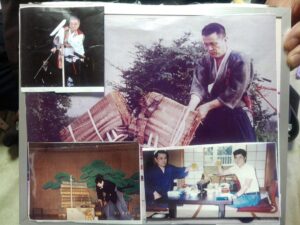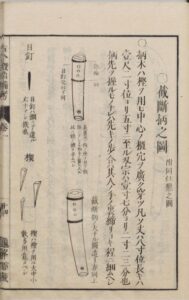Tsurube-otoshi(釣瓶落) is a technique primarily used in Dotangiri(土壇切り), or sudden and decisive cutting, and it also serves as a training method to strengthen the legs, hips, and overall physical power.
Regarding battô (sword drawing), we follow the principles of Tsurube-nuki(釣瓶抜), so in this article, we will focus on explaining the downward cutting motion.
For details on battô (sword drawing), please refer to the section on Tsurube-nuki(釣瓶抜) below link.
Dotangiri(土壇切り) is the origin of the term “dotanba(土壇場),” which refers to critical situations or the final stage of something.
“Dotan(土壇)” means an earthen platform, a raised mound of earth.
During the Edo period, the bodies of executed criminals (excluding samurai, monks, women, and children) were used for test cutting.

Kokon Kaji Biko 古今鍛冶備考 (1830)
An example of a dotan used in test cutting.
This practice served two purposes: testing the sharpness of a blade, which was referred to as tameshi-mono(様物), or test objects, and testing the skill of the swordsman.
The test cutting was performed by placing a corpse on a dotan, or earthen platform, and securing it in place.
However, until the early Edo period, a more brutal form of test cutting known as iki-Dameshi(生き試し), meaning live testing, was carried out on living criminals.
It is believed that this practice of live testing is the origin of the term dotanba(土壇場), which refers to a critical or final moment.
It is said that as the Edo period progressed into its later years, samurai became more timid and physically weaker. As a result, test cutting as a means of proving one’s skill, as well as tsujigiri (cutting down passersby), came to be avoided and gradually fell out of practice.
Explanation of the procedure
For beginners, please start from the musubi-dachi 結び立ち stance.
First, place the sword upright at your left side using your left hand.
Place your right hand on the hilt.
Perform sayabiki (pulling the scabbard back) with your left hand.
For beginners, be careful not to move your right hand during Sayabiki motion.
Extend your right elbow and draw the sword.
Place your left hand on the hilt.
While bringing the sword straight down in a vertical cut (Makkô 真っ向), open both knees and bend them deeply to assume a sonkyo 蹲踞 (crouching) posture, leaning your body forward.
Once the sword comes to a complete stop, immediately step out evenly with the left foot followed by the right foot to assume bajô-dachi 馬上立ち stance, and hold zanshin in seigan-no-kurai 青眼の位 posuture.
After maintaining zanshin 残心, proceed to tônô 刀納 (Also called Nôtô 納刀. sheathing the sword).
There is no fixed method for tōnō, but here we will use the basic type for beginners.
About the downward cutting posture
Correct posture
- Lean your upper body forward so that your back is almost parallel to the floor, without rounding your back.
- Keep both arms nearly vertical and place both fists close to your body.
- Do not let the shoulder joints extend forward relative to the torso; instead, pull the shoulder blades back.
- Lift both heels off the ground.
Example of incorrect posture
- Upper body is not leaning forward
- Arms are not vertical, and the fists are positioned too far forward.
- Normally, the goal is to cut as far out as possible, but in dotangiri, the farther the sword moves away from the body, the weaker the power becomes. Therefore, the fists should be kept as close to the body as possible.
- Back is rounded
About posture
If the sonkyo posture is too difficult, lower your body as much as you can within your range of ability.
Try to lean forward as much as possible, and get used to the posture by doing it within a comfortable and manageable range.
While maintaining that posture, move your body up and down as if stretching, and train yourself to gradually lower your body over time.
Angle of the sword during the downward cut
At the end of the cut, the sword should be approximately horizontal, parallel to the floor.
It goes without saying, but be careful not to strike the floor.
However, swing down with such tremendous force as if you were cutting all the way to the floor.
In test cutting, a dotan is prepared because the blade passes through the target and cuts into the dotan as well.
Transition into Bajô-dachi 馬上立ち
When transitioning from the sonkyo 蹲踞 posture to bajô-dachi 馬上立ち (horse-riding stance), step out with the left foot first, followed by the right foot.
At actual speed, the movement appears almost simultaneous, but the left foot slightly leads.
Recommended training method
This is a squat-style suburi based on the application of tsurube-otoshi.
While not a traditional training method, it is an effective way to develop strength and coordination in the legs and hips.
From the tsurube-otoshi position, turn the sword to the left and right while raising it overhead, and at the same time, lift your body upright.
At this moment, try to extend your elbows as much as possible and use the motion of raising the sword to help you stand up.
The goal is not simply to train leg strength, but to learn how to rise using coordinated movement of the entire body.
There is no fixed number of repetitions, but performing 30 repetitions per set for 2 to 3 sets is recommended.
At first, try doing it twice a week, and once you’re comfortable, you can shift to doing it occasionally—such as once every two to three months—for balanced improvement.
The important point is that this is not just simple muscle training.
The purpose is to develop comprehensive physical function, including but not limited to muscular strength.
If you focus only on building muscle, you may develop habits of unnecessary tension and wasted effort, which can hinder functional improvement.
About actual dotangiri
What we have described so far is the formalized version of the technique.
In actual dotangiri, the practitioner arches the back and raises the sword overhead to the point where the back of the blade (mine) nearly touches the back.
Let us now introduce several illustrated examples of dotangiri postures from the Edo period.

Test cutting by Tenshin Sensei in his youth
Even today, although not on human bodies, there are styles that perform test cutting on multiple tatami mats and similar targets.
In general, standard sword fittings are used for these demonstrations.
However, traditionally, when such powerful test cutting was performed, it was common to use specially designed fittings known as kiritsuka 切柄 (or kirizuka; Hilt designed for cutting), which often included reinforced hilts and sometimes specialized guards (tsuba), to withstand the intense impact.


The way of cutting and the posture at the end of the cut can vary depending on the size of the target and its position relative to your body.
It is a good idea to practice boldly using a wooden sword (Bokken 木剣) or a Marudachi 丸太刀(袋竹刀 Fukurijinai).
However, be careful, as a strong recoil may impact your lower back. There is a risk of injuring it.
In Conclusion
The late Ishii Sensei once told Tenshin Sensei, “Cut with distinction”.
Dotangiri is one form of this “cutting with distinction”.
While relaxation is important, it does not mean weakness is being encouraged.
On the contrary, muscular strength—so long as it functions optimally—is never a disadvantage.
However, the ability to generate great power must come after mastering correct posture and proper movement.
The correct order of priority is: functional physical capability, body control, and then technique.
This is often forgotten, and the means can easily become the end.
When training becomes too narrowly focused, it can result in the practitioner becoming capable of nothing else.
Keep in mind that test cutting is a technique—a method—not the ultimate goal. Train with this understanding in mind.


コメント